With the Feb. 25 trade deadline quickly approaching, those in the hockey world are looking at what that means for teams, and players potentially on the move. For teams, it comes down to whether they will be buyers or sellers. For players, it’s simply whether they will play the remainder of the season with their current team or if they’ll finish the campaign in a different sweater.
Related: Predators’ History at the Trade Deadline
For the Nashville Predators, it’s no different as general manager David Poile will have some key decisions to make. With a 32-19-4 record and sitting second in the Central Division and fourth in the Western Conference, the team will clearly be a buyer at the deadline. But what areas do they need to address via trade acquisition, and what assets do they have to make trades? Those are questions I will answer in this article.

What Are the Predators’ Needs?
The Predators may firmly be in a playoff spot with a dominant top line, great goaltending and one of the league’s best defense corps, but that doesn’t mean there aren’t holes on the roster.
Second-Line Help
As mentioned above, the Predators’ top line of Viktor Arvidsson, Filip Forsberg and Ryan Johansen is dominant with 49 goals and 106 points between them and that’s with Arvidsson and Forsberg missing a combined 24 games. The line also has great five-on-five metrics with a 58.1 shots for percentage, 55.6 goals for percentage, 61.0 scoring chances for percentage and 66.1 high-danger chances for percentage.
However, there’s a significant dropoff in production after the first line. Despite the missed time, the trio on the top line represent three of the top four Nashville forwards in points with Kevin Fiala as the other forward. Fiala plays on the second line, and while the points are there with 29 in 55 games, he only has nine goals. That represents a career low in points-per-60 minutes, both at five-on-five and in all situations. He is also shooting a career-low 8.2 percent and isn’t attempting shots at a normal rate.
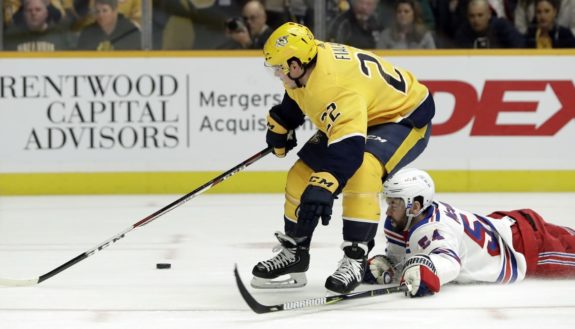
The opposite winger on the second line, Craig Smith, is having a typical season with 15 goals and 26 points in 55 games and he has the second-highest goals-per-60 minutes at five-on-five of his career. His shooting percentage is in line with his career average and his shots-per-game and shots-per-60 minutes rates are elevated, so his goal total makes sense. He does, though, have relatively few assists, largely the result of Fiala’s low shooting percentage and the turnover that has occurred at the second-line center position.
Kyle Turris has been the team’s second-line center since they acquired him from the Ottawa Senators in Nov. 2017. This season, though, Turris has only played in 30 games with six goals and 18 points. His two injury stints have resulted in Fiala and Smith playing with Calle Järnkrok, Colton Sissons and, most recently, Nick Bonino.
Bonino, a veteran with two Stanley Cups, is having a good season with 14 goals and 13 assists in 54 games. His 27 points result in his third-highest points-per-game rate. The problem is that he is a third-line center and perfectly fits that role, and although he’s having a career season, it’s unfair to expect him to maintain this production.
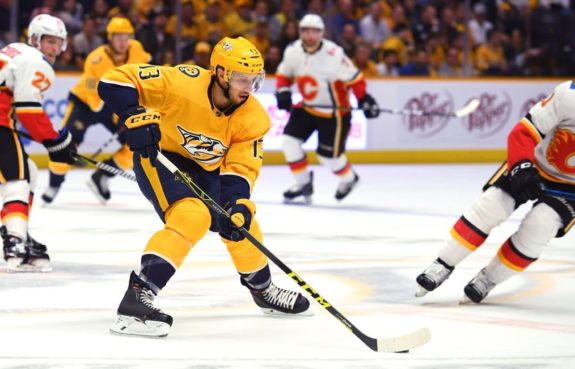
The combination of Fiala’s goal-scoring struggles and Turris’ absence leads to the Predators needing help on the second line, especially on the wing if Turris produces when he returns. Smith is having a solid season again, but the team needs someone opposite of him who can bump Fiala down the lineup and be trusted to put the puck in the back of the net. Ideally, this player would be a left shot to break up Nashville’s right-shot heavy forward group and would address the next need, as well.
A Net-Front Presence
Something the Predators have struggled with the majority of this season, although they have been better in recent games, is establishing net-front presence in order to screen the goalie, generate deflections and take advantage of rebounds. For the majority of the season, a large portion of their goals have been scored off the rush or have been the result of broken plays as opposed to scoring off a designated setup in the offensive zone.

The chart above shows that the Predators score goals from in close to the goaltender, which is a good thing as those locations provide teams and players with the highest likelihood of success. These locations could even suggest that the team is getting plenty of net-front presence. But, if you have watched many Predators games this season, you know that’s not the case. Oftentimes, their goals scored near the goal mouth are the result of driving the net or two-on-one opportunities. This becomes more evident when looking at the team’s heat maps of shots for the season.
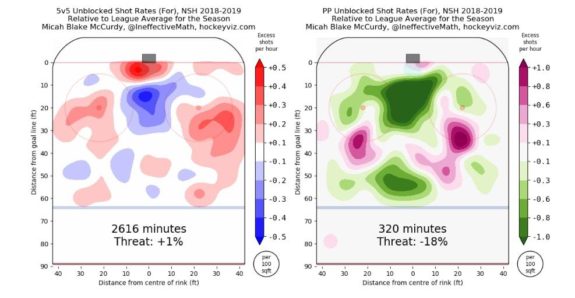
Looking at the two above charts, it shows that the Predators attempt a majority of their shots from only a few locations. At five-on-five (the chart on the left), they attempt shots from at or beyond the faceoff dots and really close to the goaltender. It’s a similar situation on the power play (the right chart) except the shots near the goal mouth are absent.
In both situations, the location that is almost entirely absent is the slot, typically a location that leads to high-danger scoring chances with a high probability of success. By comparison, the Tampa Bay Lightning and Calgary Flames, the league’s top two teams, generate the majority of their shots from the slot. They also happen to be the two highest scoring teams this season.
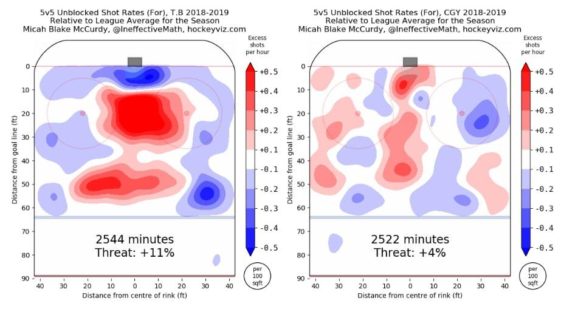
Now, assuming Predators head coach Peter Laviolette isn’t going to change his system three-quarters of the way through the season, the team is unlikely to start generating more chances from the slot. That’s also partially the result of the team’s talented defense corps that is responsible for 31.6 percent of the team’s total points. Because shots attempted by defensemen are typically generated from beyond the faceoff dots, or at the very least outside the slot, the addition of a net-front presence becomes all the more important.
On the the current roster, Arvidsson, Bonino and newcomer Brian Boyle are the only players willing to go to the front of the net and possess the necessary skills to score on deflections and rebounds, plus screen the opposing goaltender. The issue I have with this is that Arvidsson also has a lethal shot that is minimized by him going to the net.
Adding a talented winger who is tough enough to take the abuse that comes with going to that area of the ice while still talented enough to score skilled goals will benefit the team two-fold: it gets Arvidsson into more of a shooting positions, and best capitalizes on the team’s roster structure with its elite blue line.
Possibly a Seventh Defenseman
If there are two things teams can never have enough of in the playoffs, it’s center and defense depth. The Predators are no different. I was originally going to discuss how they needed additional center depth, but then on Feb. 6, Poile acquired Boyle from the New Jersey Devils for 2019 second-round pick.
The #Preds have acquired forward Brian Boyle from the New Jersey Devils in exchange for a second-round pick in the 2019 NHL Draft >> https://t.co/gvfjrMQKxc
— Nashville Predators PR (@PredsPR) February 6, 2019
The other type of depth they need is on the blue line. The top-five of Mattias Ekholm, Ryan Ellis, Dan Hamhuis, Roman Josi and P.K. Subban has been as expected: consistently productive, even if there have been stretches of questionable defensive play. Hamhuis, whom the Predators signed as a free agent last offseason, has been really solid at playing a shutdown and penalty killing role on the third pair. What has been questionable, though, is his defense partner at times.
Related: Grading Predators’ Offseason Additions
While the Predators’ top-five is cemented, the sixth defenseman has been a rotation of Anthony Bitetto, Matt Irwin and Yannick Weber. Well now Bitetto is gone via waiver claim, leaving Irwin and Weber. When together, Hamhuis and Irwin have been quite good and rank well among Nashville’s defense pairs. Of their nine pairs with at least 50 shared five-on-five minutes, they rank second in Corsi, third in relative Corsi, third in goals for and relative goals for percentages, first in shots-against per-60 minutes and giveaways per-60 minutes and third in on-ice save percentage.
However, when Hamhuis has been paired with Weber, it has not gone well as Weber drags Hamhuis down. As a result, it would not be in the team’s best interest to play Hamhuis and Weber together long-term in the case something happens to Irwin.
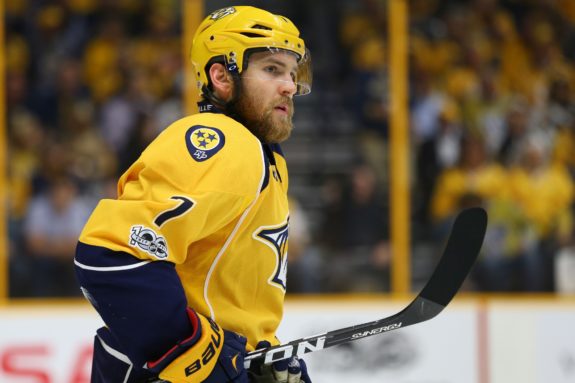
The Predators have plenty of blue line depth in the AHL, but none of them have been in the NHL this season, and waiting until the stretch run or postseason to establish chemistry in a shutdown role could be problematic. Therefore, I feel it would be smart for the team to add a low-cost seventh defenseman who is consistent and trustworthy.
What Assets Do they Possess to Make Trades?
Luckily, the Predators have the assets to address these needs even if they don’t have a high-end farm system. Their asset pool starts with draft picks. In 2019, they currently have their own first, fourth, fifth, sixth and seventh round selections, as well as the Florida Panthers’ third and the Colorado Avalanche’s fourth. In 2020 and 2021, they have all of their own picks.
They also have some solid prospect depth at the various levels and it starts with Eeli Tolvanen in the AHL and Dante Fabbro at Boston University. Both are high-end prospects that I would prefer the team not move, and it will take a big incoming piece for Poile to trade either player. Beyond them, there are quality players like Yakov Trenin, Anthony Richard, Alexandre Carrier, Frédéric Allard and Emil Pettersson in the AHL. They also have David Farrance and Jáchym Kondelík in the NCAA and both are intriguing prospects.
It’s clear the Predators have the necessary pieces to fill any needs they have at the 2019 Trade Deadline. In the next week or so, I’m going to go through the league and look at potential trade partners for the team and see what players those teams may have available and how strong of a fit the two franchises could be. Stay tuned.
*All stats are from Hockey-Reference, Natural Stat Trick, HockeyViz and IcyData